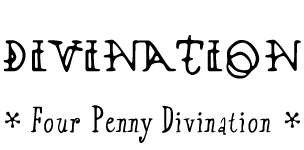 |
 This divination technique is based on the practice of "throwing coconut," which is probably the method of divination used most often in Santeria. The four-penny technique presented here is independent not only of all religious aspects of Santeria, but is taken out of the context of all religious practices entirely. The four-penny divination is a quick, handy and accurate method that can be used by anyone. Throwing coconut involves tossing four pieces of coconut (the meat of the coconut is usually used, but the shell can also be employed) to the floor to obtain a response to queries. This will result in one of five possible patterns falling based on how many pieces fall face up and how many fall face down. The patterns and their interpretations are: ¸¸¸¸ Alafia - means, "yes" and predicts peace and happiness but this is a tentative answer. If alafia falls, repeat the process of tossing the coconut. If alafia falls twice or if it is followed by ellife or itagua, positive outcomes are predicted. If alafia is followed by oyekun or ocana-sode, the potential for negative outcomes is great. ˇ¸¸¸ Itagua - means yes but is also a tentative answer. If itagua falls, there has generally been a mistake in the divination procedure. The question may need to be reformulated. It is also possible that the topic of questioning is not the topic of true concern. ˇˇ¸¸ Ellife - is the strongest and most definite answer and indicates peace and the most positive of outcomes. ˇˇˇ¸ Ocana-sode - means no and indicates the possibility for negative outcomes. ˇˇˇˇ Oyekun - is a very strong and severe form of no and indicates high potential for extremely negative and undesirable outcomes. There are specific procedures that are followed when throwing coconut, including precise ways to refresh the coconut pieces, specific chants and salutations made to the orishas. The coconut becomes the voice of whichever orisha is being consulted. Eleggua is the orisha most often addressed in this procedure. Pieces of coconut, which break or have crack are never used when speaking with the orishas. The four-penny technique preserves the use of four objects, which are used as a focal point by the person doing the divination. The essence of the meaning of each pattern above remains the same. The difference is that the pennies (any evenly weighted object with two easily discernable sides so that the patterns can be read with merely a glance so as to not interrupt concentration and the flow of the process can be used, I recommend coins because most people will be able to locate four coins at a moments notice wherever they may be) are not acting as the voice of deity, but instead, will act as locators for information. As each pattern falls in response to a query, it is like the call number in a library catalog system and is a guide to finding the exact information desired. To do a four-penny divination, get four pennies and hold them cupped in your palms. Let the pennies adjust to the temperature of your hands and become familiar with the way they feel, their size, weight and shape. Once this is done, begin to shake the pennies in your hands and focus on the sound and feel of them as they jingle. Do not become entirely absorbed by the pennies, but think of them as the conversation you are having with the people you're sitting at the table with eating dinner in a restaurant. The pennies, like your dinner companions, have your "main" attention, but you can still hear the conversations of people at other tables on the periphery of your awareness. Even though you are aware of, and can understand the background conversations, you are not distracted from the conversation at your own table. Once you have reached this state of dual awareness, you can have the querent begin asking about their areas of concern. Repeat the question while shaking the pennies and as you finish speaking, toss the pennies to the floor. As you glance down to see the pattern, you will find yourself able to reference the information pertinent to the query. As you continue with the divination, you will find that, if the querent is someone other than yourself, you will be able to formulate the questions, which should be addressed by the divination without their input. The basis of the four-penny divination is in achieving a fluidity and expansion of awareness. The information people seek when they perform divinations exists in what some call the "Akashic records," this technique facilitates a change in consciousness, which allows access to the information.


|
 |
 |


